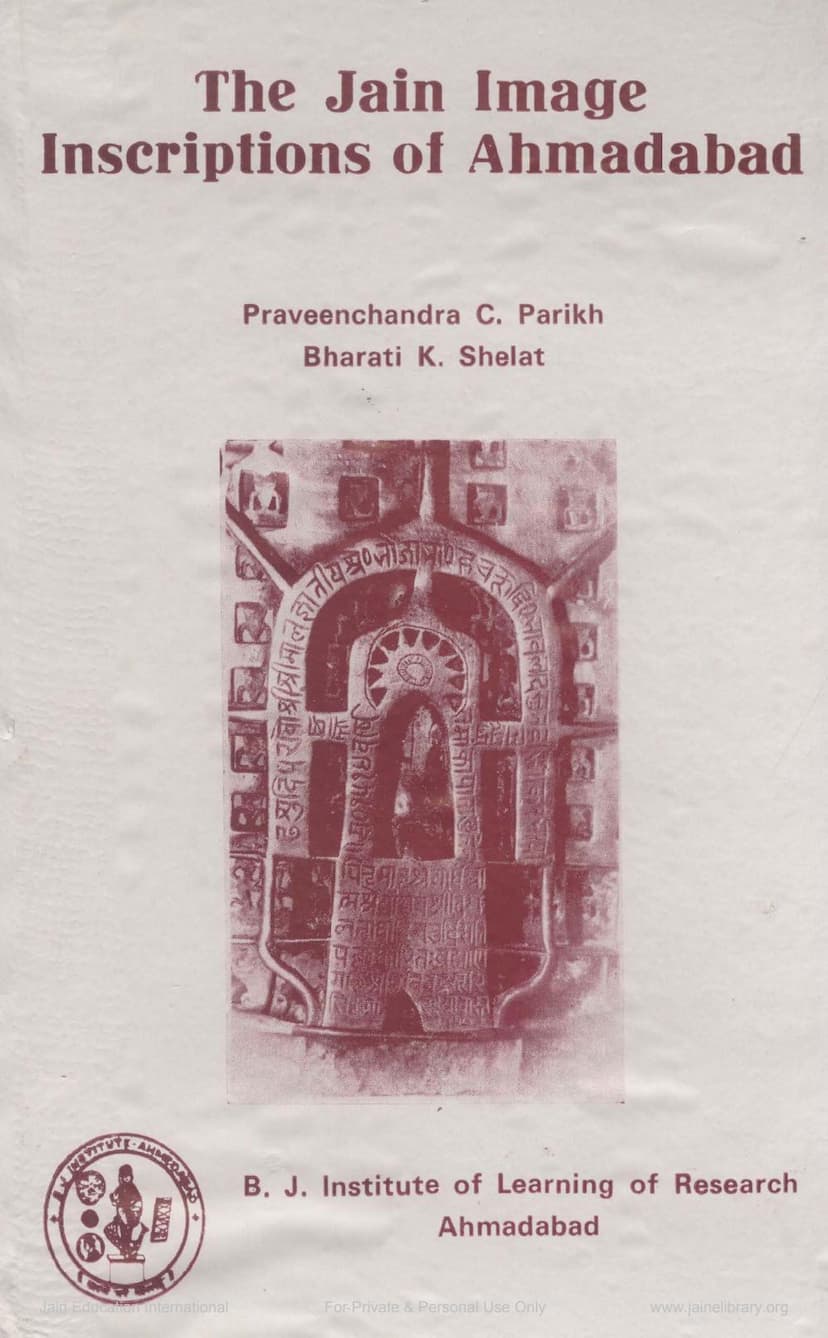Jain Image Inscriptions Of Ahmedabad
Added to library: September 2, 2025

Summary
This document summarizes the book "Jain Image Inscriptions of Ahmedabad" by Pravinchandra C. Parikh and Bharati K. Shelat, published by the B. J. Institute of Learning and Research, Ahmedabad.
Key aspects of the book:
- Focus: The book is an intensive study of Jain image inscriptions found in Ahmedabad, a significant center for the Jain community in Gujarat.
- Scope: The project, funded by the Indian Council of Historical Research, New Delhi, surveyed approximately 1,000 image inscriptions from various Jain temples in Ahmedabad between 1989 and 1992. Out of these, about 850 inscriptions were studied and incorporated into the publication.
- Content: The book presents the Sanskrit text of the inscriptions with critical notes in English. It also includes seven appendices containing lists related to:
- Installed icons of Tirthankaras and Jain deities.
- Sūris and Ācāryas.
- Gacchas (lineages).
- Gotras (clans).
- Caste-names.
- Place-names.
- Personal names of donors.
- Methodology: The inscriptions are primarily found on marble and bronze images, with some on stone and copper plates. The inscriptions are typically incised on the back of metal images and on the pithika (base) of marble images.
- Historical Significance: The inscriptions are primarily religious in nature, recording details about donors, the Sūris who installed the images, and installation dates. They are valuable for understanding the religio-cultural history of Ahmedabad and Jainism, providing insights into various Śrāvaka (Jain lay follower) castes, Gacchas, pattāvalis (lineages of spiritual preceptors), Gotras, and geographical locations that were centers of Jainism from the 13th to the 16th century AD.
- Dating and Language: The inscriptions are generally dated in the Vikrama Era, often including the year, month, tithi (lunar day), and sometimes the week-day. The language is Sanskrit with a colloquial touch, and the script is Nāgarī, prevalent from the 13th to the 16th century AD. The study notes a majority of dates align with the Kārttikādi Amānta system of years and months.
- Worship Practices: The inscriptions highlight the merit attached to the installation of Jina-bimba (images of Jinas) for spiritual bliss. They also mention contributions of images of great Sūris.
- Popular Tirthankaras: The study infers that the worship of Ādinātha was the most popular, followed by Sumatinātha, Sambhavanātha, Śāntinātha, Kunthunātha, Pārśvanātha, and Vāsupūjya, in descending order.
- Additional Deities: Besides the 24 Tirthankaras, inscriptions mention images of Ambikā and Padmāvatī.
- Prominent Sūris: Lakṣmisāgarasūri is noted as having installed the highest number of images, followed by Śrīsūri, Somasundarasūri, Jayakeśarisūri, Jayacandrasūri, Jinacandrasūri, Udayasāgarasūri, and Kakkasūri.
- Prominent Ācāryas: Kakudācārya, Kālakācārya, Kundakundācārya, Bhavadevācārya, and Siddhācārya are mentioned.
- Prominent Gacchas: Tapā Gaccha is frequently referenced, along with others like Añcala, Āgama, Kharatara, Brahmāņa, Pippala-Pispala, Nāgendra, Hārija, Bhāvaļāra-Bhāvadaharā, Vrddha tapā, Maladhārī, Saņḍera, Pūrņimā, Nāņakiya-Jñānakiya, Nāņāvāla, Jirāpalliya, Caitra, and Koranța.
- Prominent Castes: Śrāvakas who commissioned the images belonged to various castes including Prāgvāta, Śrīmāla, Ukēśa, Usavāla, Gurjara, Disāvāla, and Hurbada.
- Acknowledgement: The authors express gratitude to the Indian Council of Historical Research for their grant, to the trustees of various Jain temples for access, and to Krishna Printery for the printing.
Overall Purpose: The book serves as a valuable resource for scholars and individuals interested in Jain studies, providing detailed information derived from the epigraphic evidence of image inscriptions in Ahmedabad, spanning several centuries and offering insights into Jain religious practices, social structures, and the history of art and architecture in the region.
The provided text includes a substantial portion of the book, detailing individual inscriptions with their Sanskrit text (transliterated) and English translations, covering a wide range of Tirthankaras, donors, Sūris, Gacchas, and dates from the 13th to the 16th century AD.